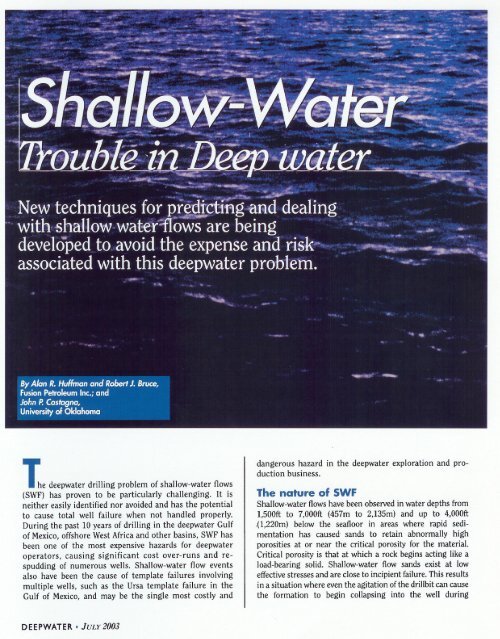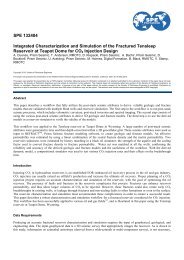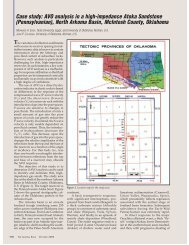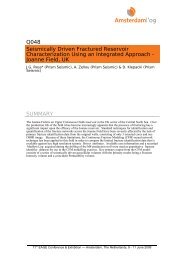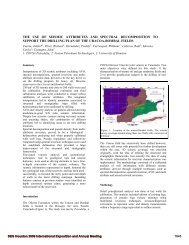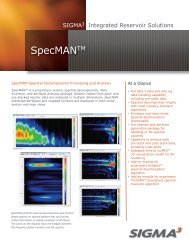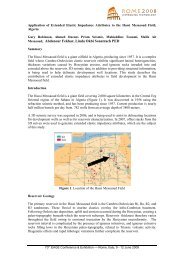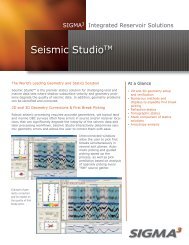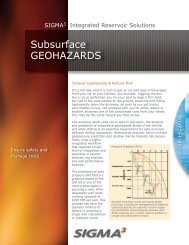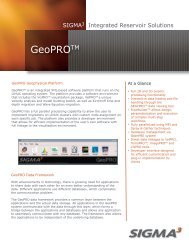Shallow Water - Trouble in the Deep - Lumina Geophysical
Shallow Water - Trouble in the Deep - Lumina Geophysical
Shallow Water - Trouble in the Deep - Lumina Geophysical
Create successful ePaper yourself
Turn your PDF publications into a flip-book with our unique Google optimized e-Paper software.
te deepwaterdrill<strong>in</strong>g problem of shallow-water flows<br />
(SWF) has proven to be particularly challeng<strong>in</strong>g. It is<br />
nei<strong>the</strong>r easilyidentified nor avoidedand has <strong>the</strong> potential<br />
to cause total well failure when not handled properly.<br />
Dur<strong>in</strong>g <strong>the</strong> past 10 years of drill<strong>in</strong>g <strong>in</strong> <strong>the</strong> deepwater Gulf<br />
of Mexico,offshoreWestAfricaand o<strong>the</strong>r bas<strong>in</strong>s, SWFhas<br />
been one of <strong>the</strong> most expensive hazards for deepwater<br />
operators, caus<strong>in</strong>g significant cost over-runs and respudd<strong>in</strong>g<br />
of numerous wells. <strong>Shallow</strong>-water flow events<br />
also have been <strong>the</strong> cause of template failures <strong>in</strong>volv<strong>in</strong>g<br />
multiple wells, such as <strong>the</strong> Ursa template failure <strong>in</strong> <strong>the</strong><br />
Gulf of Mexico,and may be <strong>the</strong> s<strong>in</strong>gle most costly and<br />
dangerous hazard <strong>in</strong> <strong>the</strong> deepwater exploration and production<br />
bus<strong>in</strong>ess.<br />
The nature of SWF<br />
<strong>Shallow</strong>-water flows have been observed <strong>in</strong> water depths from<br />
I,500ft to 7,OOOft(457m to 2,135m) and up to 4,OOOft<br />
,(1,220m) below <strong>the</strong> seafloor <strong>in</strong> areas where rapid sedimentation<br />
has caused sands to reta<strong>in</strong> abnormally high<br />
porosities at or near <strong>the</strong> critical porosity for <strong>the</strong> material.<br />
Critical porosity is that at which a rock beg<strong>in</strong>s act<strong>in</strong>g like a<br />
load-bear<strong>in</strong>g solid. <strong>Shallow</strong>-water flow sands exist at low<br />
effectivestresses and are close to <strong>in</strong>cipient failure. This results<br />
<strong>in</strong> a situation where even <strong>the</strong> agitation of <strong>the</strong> drillbit can cause<br />
<strong>the</strong> formation to beg<strong>in</strong> collaps<strong>in</strong>g <strong>in</strong>to <strong>the</strong> well dur<strong>in</strong>g<br />
DEEPWATER. JULY 2003
Drill<strong>in</strong>g-<br />
<strong>Shallow</strong> <strong>Water</strong> Flows<br />
;S<br />
Co<br />
.<br />
a<br />
Sel<br />
Z<br />
3<br />
4<br />
5<br />
6<br />
7<br />
8<br />
9<br />
10<br />
.1 .2<br />
.3<br />
Pressure (kpsl)<br />
~ .S -6 .7 -S .9<br />
Owrburdm<br />
(100 fi \\'D)<br />
E1fectM Stress<br />
(100 Ii \\'D)<br />
LEGEND<br />
100 It waler depth<br />
4000 It waler depth<br />
Effective Slmt$<br />
(4000 ft \\'Di<br />
Overourdm<br />
(-toaG<br />
ft WO)<br />
Figure 1: A comparison of shallow water and deepwater pressure<br />
environments shows <strong>the</strong> differences between <strong>the</strong> effective stress/<br />
overburden and pore pressure for water depths of 100h (30.Sm)<br />
and 4,OOOft(1,220m).<br />
penetration or soon after. Some SWFevents have been delayed<br />
by several hours to several days. Because it "excavates" <strong>the</strong><br />
formation, SWF has resulted <strong>in</strong> failure of <strong>the</strong> shallow portion<br />
of wells long after <strong>the</strong> section had been cased.<br />
To understand SWF, it is useful to understand <strong>the</strong> basis<br />
of <strong>the</strong> old truism that "compaction beg<strong>in</strong>s at <strong>the</strong> seafloor."<br />
This empirical observation is based on <strong>the</strong> physical<br />
phenomenon that compaction, which <strong>in</strong>cludes consolidation,<br />
reduction of porosity and streng<strong>the</strong>n<strong>in</strong>g of <strong>the</strong><br />
sediments, is because of <strong>the</strong> gra<strong>in</strong>-to-gra<strong>in</strong> forces <strong>in</strong> <strong>the</strong><br />
sediments. This is <strong>the</strong> effective stress or <strong>the</strong> difference<br />
beh'l'een <strong>the</strong> overburden and <strong>the</strong> pore fluid pressures.<br />
In cases of rapid sedimentation, pore fluids may not<br />
escape, as <strong>the</strong> load <strong>in</strong>creases. The fluids bear some of <strong>the</strong><br />
weight of <strong>the</strong> overly<strong>in</strong>g solids and become overpressured<br />
beyond <strong>the</strong> normal hydrostatic pressure of <strong>the</strong> overly<strong>in</strong>g<br />
waters. The effective stress on <strong>the</strong> sediments is abnormally<br />
low and <strong>the</strong> porosity is preserved.<br />
Consider a comparison of stress conditions <strong>in</strong> a shallowwater<br />
case vs. a deepwater case (Figure 1). The effective<br />
stress on <strong>the</strong> formation at <strong>the</strong> mudl<strong>in</strong>e is zero, and it <strong>in</strong>creases<br />
with a gradient of about 0.535 psi/ft if hydrostatic communication<br />
is ma<strong>in</strong>ta<strong>in</strong>ed with <strong>the</strong> water column. In<br />
shallow water, <strong>the</strong> effective stress becomes non-zero at 100ft<br />
(30.5m) below sea level where <strong>the</strong> total overburden stress<br />
from <strong>the</strong> water co'umn is relatively smalL At a water depth<br />
of 4,OOOft,however, <strong>the</strong> overburden stress is larger<br />
because of <strong>the</strong> higher water column. However, as long as <strong>the</strong><br />
pore fluids are <strong>in</strong> pressure communication, <strong>the</strong> pore<br />
pressure will be <strong>in</strong>creased an equal amount. The<br />
effective stress rema<strong>in</strong>s unchanged between shallow<br />
and deep water at <strong>the</strong> same depth below <strong>the</strong> mud l<strong>in</strong>e. As a<br />
result, <strong>the</strong> consolidation of <strong>the</strong> sands is <strong>the</strong> same for equivalent<br />
depths below <strong>the</strong> mudl<strong>in</strong>e. Thus, not only are <strong>the</strong> sediments <strong>in</strong><br />
<strong>the</strong> deepwater case less compacted, but <strong>the</strong>y also are at<br />
relativelyhigher pore pressures for <strong>the</strong> same depth below sea<br />
level compared with <strong>the</strong>ir shallow water equivalent.<br />
In addition to <strong>the</strong> low compaction state for deepwater<br />
sediments, <strong>the</strong> severity of SWF may be exacerbated by <strong>the</strong><br />
presence of structural hyper-pressur<strong>in</strong>g, also known as <strong>the</strong><br />
centroid effect. This concept suggests a sand body positioned<br />
on a structure or slope will develop a pressure gradient that is<br />
e hydrostatic, even though <strong>the</strong> gradient <strong>in</strong> <strong>the</strong> surround<strong>in</strong>g<br />
sediments is non-hydrostatic. For <strong>the</strong> shallow burial conditions<br />
<strong>in</strong> which SWF events occur, <strong>the</strong> amount of structural hyperpressur<strong>in</strong>g<br />
required to cause a seal failure is not great.<br />
Solutions<br />
The <strong>in</strong>dustry has chosen to address SWF <strong>in</strong> two primary<br />
ways:<br />
... pre-drill detection and avoidance, and<br />
... detectionand mitigationwhiledrill<strong>in</strong>g.<br />
These two efforts have occurred <strong>in</strong> parallel, often with no<br />
<strong>in</strong>teraction between <strong>the</strong> efforts. The pre-drill prediction<br />
effort has been focused on seismic prediction and logg<strong>in</strong>gwhile-drill<strong>in</strong>g/pressure-while-drill<strong>in</strong>g<br />
(PWD) analysis, while<br />
<strong>the</strong> mitigation effort has been addressed by new drill<strong>in</strong>g<br />
techniques, new mud circulation approaches (especially<br />
dual-gradient drill<strong>in</strong>g) and new mud chemical treatments to<br />
prevent hole collapse.<br />
Pre-drill prediction<br />
and avoidance<br />
The most common approach to SWF prediction is tied to<br />
analog wells and analysis of seismic reflection character on<br />
data processed with standard techniques. Well locations<br />
have been chosen to avoid or m<strong>in</strong>imize exposure to<br />
suspected SWF zones. Avoidance relies on "pattern recognition"<br />
and has not always been successful. Of course,<br />
seismic time-to-depth conversion is important for predict<strong>in</strong>g<br />
<strong>the</strong> depths of <strong>the</strong>se zones.<br />
Ano<strong>the</strong>r key pre-drill tool is seismic velocity analysis for<br />
pressure prediction. Departures of <strong>the</strong>se velocities from<br />
"normal" trends have proven useful for quantify<strong>in</strong>g <strong>the</strong> degree<br />
of overpressure and allow<strong>in</strong>g accurate cas<strong>in</strong>g program design.<br />
The bases for <strong>the</strong>se techniques date to <strong>the</strong> late 1960s and have<br />
been recently applied with better accuracy and understand<strong>in</strong>g.<br />
The geophysical community has been mak<strong>in</strong>g new<br />
advances <strong>in</strong> <strong>the</strong> pre-drill detection of SWF. Research at <strong>the</strong><br />
JULY 2003.<br />
DEEPWATER
<strong>Shallow</strong><br />
Drill<strong>in</strong>g -<br />
<strong>Water</strong> Flows<br />
Universityof Oklahomasponsoredbya<br />
consortium ofcompanies<br />
led by ConocoPhillips<br />
and jo<strong>in</strong>tly fundedby <strong>the</strong> U.S.<br />
M<strong>in</strong>eralsManagementService<br />
demonstrated <strong>the</strong> usefulness<br />
of seismic data for detect<strong>in</strong>g<br />
<strong>the</strong> low shear wavevelocities<br />
and abnormally high VpNs<br />
ratios that are diagnostic of<br />
SWF sands. The basic concepts<br />
and feasibilityof <strong>the</strong>se<br />
methods have been demonstrated<br />
and extended with<br />
fur<strong>the</strong>r analysis show<strong>in</strong>g <strong>the</strong><br />
dist<strong>in</strong>ct signatures of SWF<br />
sands <strong>in</strong> a deepwater area with<br />
known SWF events (Figures<br />
2 and 3).<br />
Detection<br />
and mitigation<br />
while drill<strong>in</strong>g<br />
The overpressures ofSWFsand sections can be detected dur<strong>in</strong>g<br />
drill<strong>in</strong>g <strong>in</strong> two ways. First, <strong>the</strong> most basic form of detection is<br />
observation of <strong>the</strong> wellhead with remotely operated vehicle<br />
video while drill<strong>in</strong>g of <strong>the</strong> tophole section of <strong>the</strong> well. This<br />
section usually is drilledwith seawater <strong>in</strong>stead of drill<strong>in</strong>g muds<br />
and without mechanical pressure control, so SWF events are<br />
readily observed as dramatic flows of sandy slurries from <strong>the</strong><br />
well. The more precise method of detection is through <strong>the</strong> use<br />
of PWD technology. This has proven helpful <strong>in</strong> real-time<br />
detection and quantification of <strong>the</strong> overpressures so weighted<br />
fluids may be <strong>in</strong>troduced rapidly for flow control.<br />
Mitigation of SWF is accomplished <strong>in</strong> two ways. Some<br />
operators chose to "topset" <strong>the</strong> suspected SWF zone and<br />
<strong>the</strong>n set ano<strong>the</strong>r str<strong>in</strong>g of cas<strong>in</strong>g immediately below <strong>the</strong><br />
zone after drill<strong>in</strong>g through <strong>the</strong> zone with weighted mud to<br />
counterbalance <strong>the</strong> overpressured pore fluids. This method<br />
protects <strong>the</strong> wellbore from <strong>the</strong> <strong>in</strong>flux of pore fluids and<br />
unconsolidated sands while <strong>the</strong> SWF section is drilled, <strong>the</strong>n<br />
protects <strong>the</strong> weak formation from <strong>the</strong> heavier weighted<br />
muds needed to drill <strong>the</strong> deeper portions of <strong>the</strong> well. This<br />
~~, ... 'o.!_~_!'L~'~~_~~!'.!'U2' ~..~'~._~._"'2..~..111 ... 7" ". 7.. "" 7911813621"2 " ... ... ... .29 .., ... 972<br />
7CO<br />
...<br />
Figure 2: When estimat<strong>in</strong>g Vp/Vs ratios for shallow-waler Row detection, abnormally high Vp/Vs ratios<br />
or blue and purple anomalies between 600 ms and 700 ms <strong>in</strong>dicate possible sand boc/ies responsible for<br />
shallow-water Row.<br />
approach has proven effective but is expensive because of<br />
<strong>the</strong> requirement for <strong>the</strong> extra cas<strong>in</strong>g str<strong>in</strong>g.<br />
An alternative is to use dual-gradient techniques. The<br />
simplest of <strong>the</strong>se is riserless drill<strong>in</strong>g us<strong>in</strong>g weighted drill<strong>in</strong>g<br />
fluids. In <strong>the</strong> technique known as "pump and dump," <strong>the</strong><br />
weighted drill<strong>in</strong>g fluids are not returned to <strong>the</strong> surface but<br />
are allowed to vent from <strong>the</strong> wellbore at <strong>the</strong> seafloor. The<br />
dual-gradient is because <strong>the</strong> normal pressure build-up<br />
through <strong>the</strong> water column and <strong>the</strong> higher gradient of<br />
pressure <strong>in</strong>crease because of <strong>the</strong> weighted drill<strong>in</strong>g fluids<br />
from <strong>the</strong> seafloor downward. This technique reduces <strong>the</strong><br />
pressure of <strong>the</strong> drill<strong>in</strong>g fluids on <strong>the</strong> formation and avoids<br />
fractur<strong>in</strong>g and fluid loss <strong>in</strong>to <strong>the</strong> SWFzones while be<strong>in</strong>g able<br />
to counterbalance overpressured pore fluids.<br />
This technique has proven effective,but it has some drawbacks.<br />
O<strong>the</strong>r systems are under development to mimic<br />
riserless drill<strong>in</strong>g by provid<strong>in</strong>g mud lift from <strong>the</strong> sea floor.<br />
"Closed" dual-gradient systems are be<strong>in</strong>g developed to return<br />
<strong>the</strong> drill<strong>in</strong>g fluids to <strong>the</strong> surface, which has several advantages:<br />
... expensive muds can be recovered;<br />
a wider variety of muds can be used; and<br />
cutt<strong>in</strong>gs can be returned and exam<strong>in</strong>ed on <strong>the</strong> rig.<br />
/n..<strong>the</strong> technique known as (pump and dump,"<br />
tkg weighted drill<strong>in</strong>g fluids are not returned to <strong>the</strong> surface but are allowed<br />
tq,pe,gt.frorn <strong>the</strong> wellbore at <strong>the</strong> seafloor.<br />
DEEPWATER. JULY 2003
Drill<strong>in</strong>g -<br />
<strong>Shallow</strong> <strong>Water</strong> Flows<br />
~<br />
.]<br />
y<br />
.~<br />
about <strong>the</strong> nature of <strong>the</strong> phenomenon<br />
and how to cope with it. New and<br />
emerg<strong>in</strong>g techniques are availabJe for<br />
predict<strong>in</strong>g <strong>the</strong> existence of <strong>the</strong> sands and<br />
<strong>the</strong> degree of overpressure <strong>in</strong> <strong>the</strong>m as<br />
well as for drill<strong>in</strong>g <strong>the</strong>m safely. The<br />
skilJs and knowledge of several diverse<br />
discipl<strong>in</strong>es are needed <strong>in</strong> this effort.<br />
With communication and a common<br />
understand<strong>in</strong>g of <strong>the</strong> problem by <strong>the</strong><br />
geoscience and eng<strong>in</strong>eer<strong>in</strong>g discipl<strong>in</strong>es,<br />
progress has been made <strong>in</strong> mitigat<strong>in</strong>g<br />
<strong>the</strong> hazard and drill<strong>in</strong>g efficient<br />
deepwater wells. ~<br />
.~<br />
~1<br />
common data po<strong>in</strong>t locations on <strong>the</strong> l<strong>in</strong>e<br />
Figure3: In analyz<strong>in</strong>g <strong>the</strong> deviation <strong>in</strong> <strong>the</strong> estimated Vp/Vs ratio from background Vp/Vs<br />
from a seismic <strong>in</strong>version, purple and red zones have abnormally high Vp/Vs, possibly<br />
<strong>in</strong>dicat<strong>in</strong>g sand bodies responsible for shallow water flows.<br />
Conclusion<br />
While SWFsands have been a major ha7,ardto deepwater<br />
drill<strong>in</strong>g and development, experience has taught much<br />
About <strong>the</strong> authors: Alan R. Huffman<br />
(huffman@fusiongeo.com) is president<br />
and chief executive officer of Fusion<br />
Petroleum Technologies Inc. <strong>in</strong> The Woodlands,<br />
Texas. Robert J. Bruce is a fusion<br />
resenlOir associate at Fusion Petroleum Technologies Inc.<br />
John P. Castagna is a professor of geophysics at <strong>the</strong><br />
Universityof Oklahoma.<br />
s I<br />
103 W. Boyd St.<br />
Norman, OK 73069 F u<br />
o~<br />
405-364-8663 (phone)<br />
405-321-7571 (fax)<br />
25231 Grogan's Mill Road, Suite 175<br />
The Woodlands, TX 77380<br />
281-363-4903 (phone)<br />
281-363-4657 (fax)<br />
www.fusiongeo.com


